Boeing 737
Background
The creation of a short to medium haul airliner was conceived by Boeing in 1964, when the aircraft was seen as a competitor for the DC-9 and Bac1-11. Following design work by two competing teams, construction commenced in early 1965. The aircraft utilises the same fuselage cross-section as the earlier 707 and 727, and shares a number of components with the 727. The incorporation of a suitable APU and airstairs meant the aircraft could use airports with limited facilities. The prototype (N73700) first flew on April 9, 1967. The first production 737-100 (N2282C) followed on May 13. The series 200 was under development at the same time, and the first 737-200 flew on August 8, 1967. This rapidly became the standard model. The 737 launch customers were Lufthansa and United Airlines. Deliveries started in December 1967, and commercial services commenced on February 10, 1968.
Revision of the aircraft has been ongoing. The early models soon incorporated a freight door and modified thrust reversers. The 737-200 Advanced was introduced in 1971, along with a quick change (QC) variant. The USAF adopted the 737 as a navigation trainer under the designation T-43, with the T-43A entering service in 1974. The 737-300 which incorporated a lengthened fuselage and quieter engines was announced in March 1981, and flew in February 1983. Deliveries commenced in 1984. The 737-400 which has a further stretch was announced in June 1986 and flown in February 1988, and the 737-500 a year later. The -500 is the same size as the -200, but quieter and more fuel efficient.
The 1990's have seen Boeing introduce the 'next generation' 737. Approved by Boeing in 1993. the aircraft has a modified wing (both in chord and span), modified control surfaces, a range of engines with digital controls, a 'glass' cockpit, and incorporates a variety of composites in the construction. The aircraft comes in -600, -700, -800, and -900 versions, primarily differentiated by fuselage length. The 737-700 was first flown on February 9, 1997 and entered service in January 1998. The 737-800 followed on July 31, 1997. The 737-600 was flown on January 22, 1998. The final 'classic' 737 was completed in 1999.
In New Zealand the 737 has been used on domestic, trans-Tasman, and some Pacific island routes, with more than 40 aircraft having appeared on the civil register since 1968. (more details below). Four operators have used New Zealand registered 737 aircraft.
The first operator was the National Airways Corporation. The decision to acquire the 737 was taken in 1966 after much political debate over the choice against the Bac1-11. A contract for 3 -200 aircraft was signed on July 19, 1967, and NAC became customer '19'. NAC crews trained at Boeing, and got route experience with United Airlines. The first aircraft was delivered on September 18th, 1968 and enroute the aircraft set a 737 distance record on the Honolulu-Nadi leg. With 7 aircraft acquired, the 737 replaced the Vickers Viscount in service on June 3, 1975, with two more aircraft being subsequently acquired. In December 1977 the New Zealand Government took the decision to merge NAC and Air New Zealand, and the merger went ahead on April 1, 1978. Air New Zealand ordered 6 more -219 aircraft in 1984, and as these arrived, the older aircraft were sold to International Lease Finance Corporation (ILFC). The older aircraft were progressively hush-kitted in the mid-1990's to comply with Wellington local regulations. In December 1989 another order was announced for 6 aircraft (plus 6 options) for delivery in 1993. This was subsequently deferred to 1996, and then deferred again. Deliveries of -300 aircraft began in 1999.
The second operator was Ansett New Zealand, which commenced its operation in 1987 with three early model 737-130 aircraft (in fact the second, fourth, and fifth production aircraft) ZK-NEA/NEB/NEC and some Dash-8 aircraft. These were supplemented in 1988 by a further -112 and two -200 aircraft (a -2A6 and a -2U9) ZK-NED/NEE/NEF. The proposal to replace the aircraft with -500 models was dropped when the airlines share-holding was rearranged after the withdrawal of shareholders Brierly Investments and Newmans. The aircraft were then replaced by Bae146 aircraft which entered service in July 1989. ZK-NEB/NEC/NEE were withdrawn in December 1989, and ZK-NED/NEA/NEF in the succeeding months.
The third operator is Freedom Air. Initially set up as a low cost charter operation, Freedom Air is a wholly owned subsidiary of Mt Cook Airlines (itself a subsidiary of Air New Zealand). The new airline was announced in November 1995, and began charter operation in December before it gained its Air Services license in August 1996. Initially operating with a 757-204ER leased from Britannia Airways, this was replaced by a 737-3S1ER leased from TACA International in April 1996. In 1997 a 737-38M leased for five years from South Pacific Air Charters was introduced. This aircraft went on the New Zealand register as ZK-FDM. A second aircraft, a 737-3U3, was delivered in November 1999, and began services in December as ZK-FRE.
The latest 737 operator is Royal Tongan Airlines, which took delivery of former Air New Zealand 737-2Y5 ZK-NAF on November 11, 1999 and went into service on November 12.
A number of other leased, but not NZ registered aircraft have also operated here. Initially Freedom Air competed with Kiwi International Airlines, which collapsed in September 1997. The latter organisation started as a charter operator using leased Air Nauru 737-400s, before using a 757 and an Airbus 340. Later a 737-3Y0 (TF-ABK) was leased from the UK. Air New Zealand have used a number as maintenance replacements including G-BAZI, G-BHWF, G-BADP, C2-RN10, C2-RN11, 5W-ILF and DQ-FJB. New charter operator K2000 is operating a 737-400 (reg? ) leased for four months from Pegasus Airlines on trans-Tasman routes during the southern summer.
Details of current, and formerly New Zealand registered 737 aircraft can be seen below. (Note: in the following listing some registrations have been reused. The serial is therefore important for identifying particular aircraft).
Currently registered aircraft (as of December 1, 1999) include:
- ZK-FDM (c/n 25016, ex 00-XTG, OO-LTG, HB-IIC) 737-38M First flown February 18, 1991. Formerly operated by Trans European Airways (under lease from a variety of owners). Freedom Air has leased the aircraft for 1997-2002. Entered the New Zealand register on February 26, 1997. The aircraft arrived on March 10, 1997 and went into service on April 5.
- ZK-FRE (c/n 28742, ex ?) 737-3U3 Built for Garuda Indonesia but not taken up. Formerly operated by Pro Air. Registered to Freedom Air on November 19, 1999. Went into service in December 1999.
- ZK-NAA (c/n 22638, ex N1780B, G-BJCT, EC-DXK) 737-204 First flown March 23, 1982. Formerly with Britannia Airways, Spantex, Midway Airlines, and Euralair International. Arrived in New Zealand on November 9, 1993 and was registered to Air New Zealand on November 15. Went into service on November 21, 1993, named 'Parekareka'.
- ZK-NAB (c/n 22364, ex G-BHWE) 737-204 First flown August 26, 1980. Formerly with Britannia Airways and British Airtours. Arrived in New Zealand on February 13, 1994 and was registered to Air New Zealand on February 15. Went into service on March 7, 1994, named 'Parera'.
- ZK-NAF (c/n 23038, ex 9H-ABA) 737-2Y5 First flown March 1, 1983. Formerly with Air Malta. Arrived in New Zealand on October 2, 1994 and was registered to Air New Zealand on October 6. Remained in service until ?. Registration transferred on November 11, 1999. Currently operated by Royal Tongan Airlines, which took delivery of the aircraft on November 11, 1999 and went into service on November 12. Plans to re-register the aircraft as ZK-RTA were dropped.
- ZK-NAI (c/n 22365, ex N57001, G-BHWF) 737-204 First flown September 10, 1980,. Formerly with Britannia Airways, and Midway Airlines. Previously leased to Air New Zealand by Britannia Airways from January 19 to April 30, 1988. Arrived in New Zealand on December 16, 1993 and was registered to Air New Zealand on December 17. Went into service on January 17, 1994, named 'Poaka'.
- ZK-NAT (c/n 23470, ex --) 737-219 First flown January 2, 1986. Handed over to Air New Zealand on January 16, 1986. Registered January 17, 1986, and arrived in New Zealand on January 21. Went into service January 31, 1986, named 'Pihoihoi'. Fifth Air New Zealand 737 to be hush-kitted, being test flown on May 20, 1994.
- ZK-NAU (c/n 23471, ex --) 737-219 First flown January 6, 1986. Handed over to Air New Zealand on January 21, 1986. Registered January 22, 1986, and arrived in New Zealand on January 26. Went into service February 7, 1986, named 'Pateke'. Second Air New Zealand 737 to be hush-kitted, being test flown on October 4, 1992
- ZK-NAV (c/n 23472, ex --) 737-219 First flown January 20, 1986. Handed over to Air New Zealand on February 10, 1986. Registered February 3, 1986, and arrived in New Zealand on February 15. Went into service February 21, 1986, named 'Pukeko'. Fourth Air New Zealand 737 to be hush-kitted, being test flown on January 4, 1994.
- ZK-NAW (c/n 23473, ex --) 737-219 First flown January 28, 1986. Registered to Air New Zealand on February 3, 1986, and arrived in New Zealand on February 18. Went into service February 27, 1986, named 'Pourourou'. Third Air New Zealand 737 to be hush-kitted, being test flown on April 4, 1993.
- ZK-NAX (c/n 23474, ex --) 737-219 First flown February 3, 1986. Handed over to Air New Zealand on February 18, 1986. Registered February 3, 1986, and arrived in New Zealand on February 24. Named 'Piere'. Sixth Air New Zealand 737 to be hush-kitted, being test flown on July 1, 1994.
- ZK-NAY (c/n 23475, ex --) 737-219 First flown February 14, 1986. Handed over to Air New Zealand on March 5, 1986. Registered February 3, 1986, and arrived in New Zealand on March 9. Went into service March 14, 1986, named 'Piripiri'. First Air New Zealand 737 to be hush-kitted, being test flown on September 24, 1992.
- ZK-NGA (c/n 28873, ex N1787B) 737-33R Built for Western Pacific Airlines but not taken up. First flown December 11, 1997 Leased to Air New Zealand and registered on January 9, 1998. Arrived in New Zealand on February 11, 1998 and went into service on March 29.
- ZK-NGB (c/n 29140, ex --) 737-36Q First flown March 15, 1998. Leased to Air New Zealand and registered on March 31, 1998. Arrived in New Zealand on April 2, 1998 and went into service on May 10.
- ZK-NGC (c/n 29189, ex --) 737-36Q Rolled out on June 27, 1998, and the first flown was on July 16. Leased to Air New Zealand and registered on August 4, 1998. Arrived in New Zealand on August 6, 1998 and went into service on September 12
- ZK-NGD (c/n 28732, ex PK-GGH, N1768B, N1792B, N930W) 737-3U3 Built for Garuda Indonesia but not taken up. First flown December 10, 1997. Went into storage in January 1998. Bought by Air New Zealand in late 1998 and leased to WinAir. Entered the New Zealand register on March 19, 1999, then leased to LOT from March-October 1999.
- ZK-NGE (c/n 28733, ex PK-GGI, N6066Z, N931W) 737-3U3 Built for Garuda Indonesia but not taken up. First flown December 28, 1997. Went into storage in January 1998. Bought by Air New Zealand in late 1998 and leased to WinAir. Entered the New Zealand register on March 31, 1999
- ZK-NGG (c/n 25606, ex --) 737-319 Built for Garuda Indonesia but not taken up. Modified to -319 standard. Registered October 15,1999
- ZK-NGH (c/n 25607, ex --) 737-319 Built for Garuda Indonesia but not taken up. Modified to -319 standard. Registered October 27, 1999
- ZK-NGI (c/n 25608, ex --) 737-319 Built for Garuda Indonesia but not taken up. Modified to -319 standard. Registered November 20, 1999
- ZK-NQC (c/n 22994, ex --) 737-219QC Arrived in New Zealand on December 2, 1982 and was registered to Air New Zealand on the same day. Went into service on December 12, 1982, named 'Piopio' As the sole 'quick change' version in the Air New Zealand fleet, the aircraft has been used on a night freight run between Auckland and Christchurch in addition to passenger services Last of the Air New Zealand 737s to be hush-kitted, being test flown on September 7, 1994.
Previously registered aircraft (as of November 1, 1999) include:
- ZK-JJD (c/n 21732, ex 9M-MBJ, PK-IJF) 737-32H6 First flown February 28, 1979. Formerly operated by Malaysian Airlines and Bouraq Indonesia Airlines. Although registered in New Zealand, the aircraft did not operate here. Registered to Air New Zealand on July 10, 1998, the aircraft did not reach New Zealand. Following scheduled maintenance in Singapore, it went instead to Air Gabon. The registration had been transferred from Air New Zealand to Air New Zealand Engineering Services, and was withdrawn September 29, 1998. The aircraft subsequently becoming 3B-LXM.
- ZK-NAC (c/n 19929, ex --) 737-219 First flown August 20, 1968 This aircraft was the first 737 on the New Zealand register. The aircraft was handed over to National Airways Corporation on August 30, 1968, and arrived in New Zealand on September 18. It went into service on October 7, 1968 named 'Piripiri'. Subsequently became part of Air New Zealand in 1978. Taken out of service on March 20, 1986 the aircraft had completed 36,553 hours/ 49,806 cycles in NAC/ANZ service. The aircraft was sold to International Finance Corporation (ILFC) and departed on March 24, 1986. The registration was withdrawn on April 22, and the aircraft become N321XV.
- ZK-NAD (c/n 19930, ex --) 737-219 The second National Airways Corporation 737 arrived on September 29, 1968. It went into service on October 14, 1968 named 'Pukeko'. Subsequently became part of Air New Zealand in 1978. Taken out of service on January 30, 1986 the aircraft had completed 36,233 hours/ 49,381 cycles in NAC/ANZ service. Sold to International Finance Corporation (ILFC), the registration was withdrawn on February 28,1986 and the aircraft departed on March 1 as N322XV.
- ZK-NAD (c/n 23040, ex 9H-ABC) 737-2Y5 First flown March 23, 1983, Formerly with Air Malta. The aircraft arrived on December 1994, and was registered to Air New Zealand on January 4, 1995. The aircraft was named 'Papango' in service. The registration was withdrawn on December 10, 1995 and the aircraft departed the following day as 5B-DBF.
- ZK-NAE (c/n 19931, ex --) 737-219 National Airways Corporation's 3rd 737 arrived on October 13, 1968. It went into service on October 25, 1968 named 'Pourourou'. Subsequently became part of Air New Zealand in 1978. Taken out of service on February 2, 1986, the aircraft had completed 36,164 hours/ 48,834 cycles in NAC/ANZ service. Sold to International Finance Corporation (ILFC), the registration was withdrawn on March 27, 1986, and the aircraft departed the same day to become N453AC.
- ZK-NAH (c/n 23039, ex 9H-ABB) 737-2Y5 First flown March 17, 1983. Formerly with Air Malta, and Sobelair Arrived in New Zealand on November 9, 1994 and was registered to Air New Zealand on November 11. Went into service December 6, 1994 named 'Peho'. Leased back to Air Malta for the northern summer seasons in 1996 and 1997. Taken out of service October 30, 1997. The aircraft was then leased to Bouraq Indonesia as PK-IJL from December 97-May 98 (withdrawn from register on December 17, 1997 and restored April 9, 1998). The aircraft departed from New Zealand on May 25, 1998 and the registration was withdrawn on June 5 with the aircraft becoming N921WA
- ZK-NAJ (c/n 20344, ex N73714) 737-219 Originally built for Aloha Airlines as a 737-297, and then modified for the National Airways Corporation as a 737-219. The aircraft arrived in New Zealand on July 22, 1971. It went into service on August 22, 1971 named 'Piere'. Subsequently became part of Air New Zealand in 1978. Taken out of service March 6, 1986 the aircraft had completed 31,062 hours/ 42,267 cycles in NAC/ANZ service. Sold to International Finance Corporation (ILFC), the registration was withdrawn on April 22, 1986, and the aircraft departed on April 24 as N7310F.
- ZK-NAK (c/n 20156, ex N983PS) 737-214 Formerly with Pacific Southwest Airlines, the aircraft arrived on September 15, 1973. It went into National Airways Corporation service in December 1973 named 'Pihoihoi. Subsequently became part of Air New Zealand in 1978. It was the last aircraft in the fleet to operate in NAC colours until repainted in late 1984. Taken out of service on February 7, 1986, the aircraft had completed 25,031 hours/ 34,236 cycles in NAC/ANZ service. Sold to International Finance Corporation (ILFC), the aircraft departed March 8, 1986. The registration was withdrawn on March 10, 1986, to become N323XV.
- ZK-NAL (c/n 20158, ex N985PS) 737-214 Formerly with Pacific Southwest Airlines, the aircraft arrived on September 15, 1974 Initially used as a maintenance replacement by the National Airways Corporation, the aircraft later became part of the regular fleet schedule. Subsequently became part of Air New Zealand in 1978. Taken out of service in March 1981, the aircraft departed on April 6. The registration was withdrawn on April 9, 1981 to become N4264Y.
- ZK-NAL (c/n 21138, ex N1787B, VR-UEC, VS-UEC, V8-UEC, 9M-MBQ) 737-2M6 First flown July 17, 1975. The registration OO-SDO was not taken up Formerly operated with Royal Brunei Airlines and Malaysian Airlines. Arrived in New Zealand on September 5, 1992 and registered to Air New Zealand on September 8. Went into service on September 13, 1992, being taken out of service again on December 8. The registration was withdrawn on January 29, 1993, and the aircraft departed on February 4 as LV-VGF.
- ZK-NAM (c/n 19758, ex N737Q, N1359B) 737-222 First flown March 9, 1968. Used as a testbed/ demonstrator by Boeing. Purchased by the National Airways Corporation, the aircraft arrived in New Zealand on February 18, 1974. It went into service on April 1, 1974 named 'Pateke'. Subsequently became part of Air New Zealand in 1978. Taken out of service on February 28, 1986 the aircraft had completed 23,259 hours/ 31,801 cycles in NAC/ANZ service. Sold to International Finance Corporation (ILFC), the registration was withdrawn on April 17, 1986 and the aircraft departed the following day as N7320F.
- ZK-NAP (c/n 21130, ex --) 737-219 Arrived in New Zealand on September 7, 1975. Went into service with the National Airways Corporation on September 29 named 'Parekareka'. . Chartered by Boeing as a Demonstrator to Japan in May 1976. Flew the last NAC flight on March 31, 1978. Subsequently became part of Air New Zealand the following day. Departed March 2, 1994 and the registration was withdrawn on March 7 to become HC-BTI.
- ZK-NAQ (c/n 22022, ex LN-SUT) 737-205 Rolled out October 22, 1979, and first flown on November 5. Formerly with Braathans SAFE of Oslo. Arrived September 5, 1990 and was registered to Air New Zealand the same day. Went into service on September 10, 1990 initially on a three year lease, which was later extended. The aircraft departed on December 28, 1994 and the registration was withdrawn on January 18, 1995 to become N8032M.
- ZK-NAQ (c/n 21131, ex N8293V) 737-219 Arrived in New Zealand on November 20, 1975 and went into National Airways Corporation service on December 19. NAC sought to sell the aircraft the following year, but a move to PH-TVM was not taken up. The aircraft was leased through Guiness Peat Aviation to Nigeria Airways in June 1976, and departed on June 20. The registration was withdrawn in July 1976, becoming EI-BCC. The aircraft was sold the following year.
- ZK-NAR (c/n 21645, ex --) 737-219 The aircraft was registered to Air New Zealand on October 12, 1978 and arrived on October 16. Named 'Parera' , it was the first 737 in Air New Zealand livery having been delivered in their colours. The registration was withdrawn on July 12, 1994 and the aircraft departed on July 19 as N237TA.
- ZK-NAS (c/n 22088, ex --) 737-219 First flown on June 16, 1980, and handed over to Air New Zealand on July 1. The aircraft entered the New Zealand register the same day, and arrived in the country on July 4, 1980. It went into service on July 21, 1980 named 'Piwakawaka. The registration was withdrawn on June 16, 1995 and the aircraft departed on June 22 as N318CM.
- ZK-NAT (c/n 22657, ex --) 737-219 This aircraft was due for delivery in March 1982, but the order by Air New Zealand was cancelled. The deposit was transferred to 737-219QC ZK-NQC which subsequently arrived in New Zealand on December 2 that year. The undelivered aircraft was sold to International Lease Finance Corporation, and went into service with DanAir as G-BJXJ.
- ZK-NAZ (c/n 20913, ex 00-SDG, VR-UEB, 4R-ALD, CC-CJZ, V8-UEB) 737-2M6 First flown February 12, 1975. Formerly with Royal Brunei, Air Lanka, and LAN Chile. Previously leased by Air New Zealand for the period February 15 to March 31, 1987 during fleet cabin refurbishment (the aircraft being in service from February 16 to March 28). Leased again by Air New Zealand, the aircraft was registered on August 5, 1988 and arrived back in New Zealand the following day. It went into service on August 15, 1988 named 'Poaka'. At the termination of the lease, the aircraft departed on September 28, 1995. The registration was withdrawn on October 2, 1995 and the aircraft became CC-CYV.
- ZK-NEA (c/n 19013, ex N2282C, D-ABEA, N701AW) 737-130 First flown on May 13, 1967. This was the second 737 built, as part of the Lufthansa order. Subsequently operated with America West Airlines. Arrived in New Zealand on May 18, 1987, and was registered for Ansett New Zealand on May 28. Ansett named the aircraft 'City of Auckland' while in service. Taken out of service on February 2, 1990, the aircraft did not depart until March 28, 1991 having been stored at Christchurch. The registration was withdrawn on April 3 1991, and the aircraft became N701PJ.
- ZK-NEB (c/n 19105, ex N2289C, D-ABEC, N2702AW) 737-130 First flown on July 5, 1967. This was the fourth 737 built, as part of the Lufthansa order. Subsequently operated with America West Airlines. Arrived in New Zealand on June 25, 1987, and was registered for Ansett New Zealand on July 13. Ansett named the aircraft 'City of Wellington' while in service. Taken out of service on December 13, 1989, the aircraft did not depart until April 19, 1991 having been stored at Christchurch. The registration was withdrawn on April 23 1991, and the aircraft became N702PJ.
- ZK-NEC (c/n 19016, ex D-ABED, YV-406C, N703AW) 737-130 First flown on January 20, 1968. This was the fifth 737 built, as part of the Lufthansa order. Subsequently operated with SAVAR, America West Airlines, and Challenge Air International. Arrived in New Zealand on April 27, 1987, and was registered for Ansett New Zealand on May 12. Ansett named the aircraft 'City of Christchurch' while in service. Taken out of service on December 17, 1989, the aircraft did not depart until May 21, 1991 having been stored at Christchurch. The registration was withdrawn on June 20, 1991, and the aircraft became N703PJ.
- ZK-NED (c/n 19770, ex 9M-AOV, 9V-BFE, N42AF, N709AW) 737-112 First flown on August 28, 1969. Formerly operated with Malaysia-Singapore Airlines, Singapore Airlines, Compania Panemena de Aviacion (COPA), Air Florida Inc, and America West Airlines. Arrived in New Zealand on July 17, 1987, and was registered for Ansett New Zealand on July 23. Taken out of service on January 27, 1990, the aircraft departed on April 11, 1990 having been stored at Christchurch. The registration was withdrawn on April 17, 1990, and the aircraft became N73GQ.
- ZK-NEE (c/n 20195, ex N1288, N146AW) 737-2A6 First flown on September 9, 1969. Formerly operated with Essex Wire Co, United Technologies Cortran Inc, and America West Airlines. Arrived in New Zealand on July 1, 1987, and was registered for Ansett New Zealand on July 13. Taken out of service by Ansett on December 8, 1989 the aircraft was subsequently used by Air New Zealand for two weeks from December 18 to January 1, 1990 as a maintenance replacement (in Air New Zealand service ZK-NEE was painted white with a koru on tail). The registration was withdrawn on February 2, 1990 and the aircraft departed the following day as 4R-ULL.
- ZK-NEF (c/n 22575, ex 5W-PAL, N149AW) 737-2U9 First flown on March 13, 1981. Built for Polynesian Airlines, and also operated by America West Airlines. Arrived in New Zealand on June 24 1988, and was registered for Ansett New Zealand on July 19. Taken out of service in November, 1988, the aircraft departed on November 29. The registration was withdrawn on December 1, 1988.
Last Update:- 13 December, 1999
Technical Data
Data is for 737-200
- Accommodation : 5 crew, up to 130 passengers
- Dimensions
- Span : 28.53m (93'0ft)
- Length : 30.48m (100'0ft)
- Height : 11.28m (37'0ft)
- Weight
- empty : 27,470kg (60,550lb)
- max : 52,390kg (115,500lb)
- Power Plant : 2x 6,577kgp (14,500lb st) P&W JT8D-9
- Performance :
- max speed : 927km/h (576mph)
- max climb : ft/min (m/min)
- ceiling : 35,000ft ( 10,670m)
- range : 5,190km (3,225miles)
Images
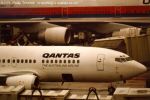
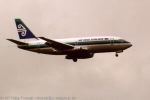

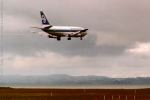
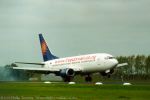
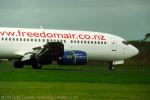
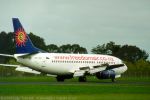
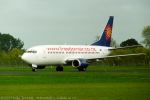

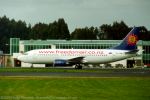

 © 1997-99 Phillip Treweek, all rights reserved
© 1997-99 Phillip Treweek, all rights reserved